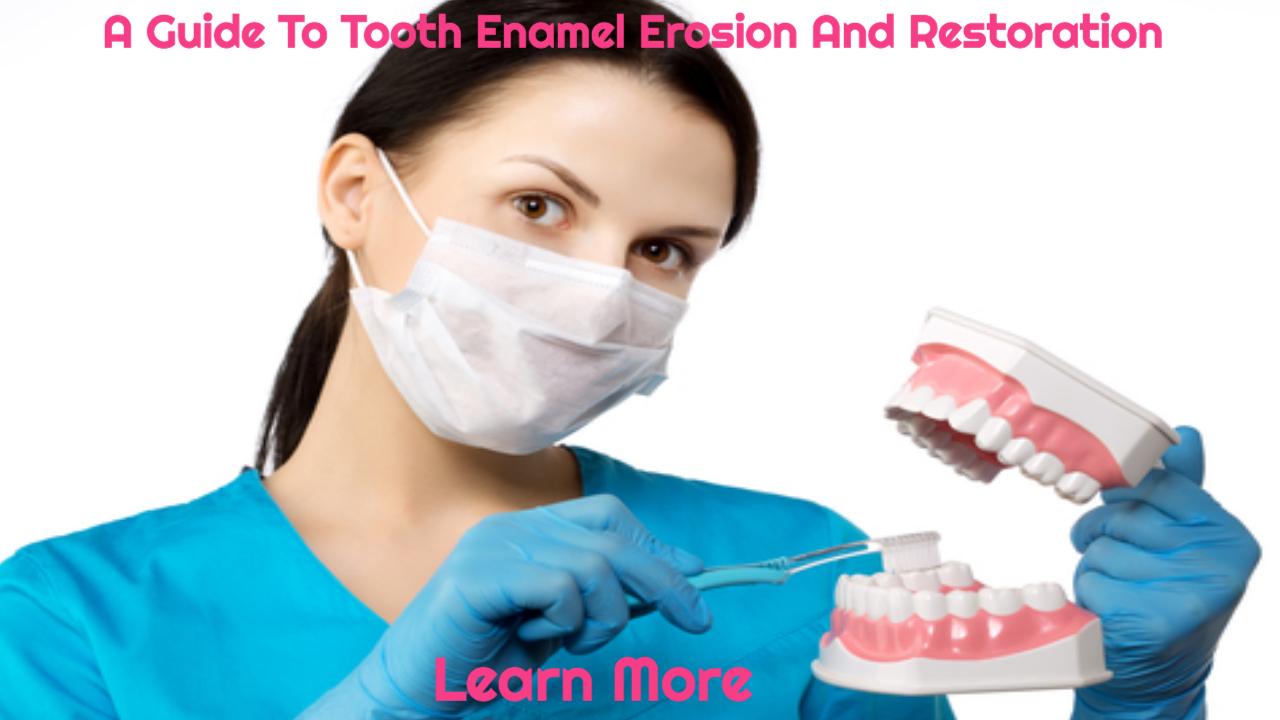Tooth Enamel Erosion – Procedures to Restore Patients’ Smiles
We all want to make certain that we are doing everything possible to prevent tooth erosion when it comes to dental care. However, tooth enamel erosion is a common disease that many people face. But how can you know whether you’re having it? There are numerous warning indicators to look out for, as this article will explain.
An Explanation of Tooth Enamel
Enamel is the thin layer that covers the tooth’s outer surface. This tough covering is the body’s most resilient tissue. Enamel covers the crown, which is visible outside the gums.
Enamel shields your teeth from everyday wear and tear, such as grinding, chewing, biting, and crunching. Enamel is a robust tooth protection, but it can also chip or split. Enamel also protects teeth from potentially hazardous substances and temperatures. You may react differently to cold or hot foods, drinks, sweets, and other substances if you have enamel.
What is Tooth Enamel Erosion and What Causes It?
Enamel is the first line of defense against toxins in food and physiological fluids. Unfortunately, it can wear out and become damaged over time. Enamel erosion is the cause of this degeneration.
The tooth surface can be damaged by wear, tear, corrosion, stress, or any combination of these factors. Tooth erosion, for example, happens when acids demineralize and wear down tooth enamel. The most common cause of enamel erosion is acidic foods and beverages. By regularly neutralizing acids in your mouth, saliva protects your enamel. However, suppose you consume excessive amounts of highly acidic foods and beverages or fail to wash your teeth correctly. In that instance, the acids in food and drinks might destroy the enamel’s outer layer.
Enamel erosion can be caused by any of the following factors:
- Poor dental hygiene
- Use the wrong kind of mouthwash
- Swigging soda
- Too much citric acid
- Regular consumption of carbonated water
- Sugar snacking
- Feasting on starches
- Guzzling alcohol
- Bruxism
- Acid reflux difficulties
- Frequent vomiting and bulimia
According to new studies, bulimia is a primary cause of tooth damage and enamel erosion. Bulimia, an eating disorder, is characterized by bingeing and vomiting. This acid has the potential to induce tooth decay. Furthermore, frequent vomiting might cause dental enamel degradation and cavities.
Does Dental Plaque Contribute to Enamel Erosion?
 Plaque is a sticky film made up of saliva, food particles, and germs. Plaque accumulates around your teeth and might enter the little pits or holes in your molars. Dental plaque can also accumulate near cavity fillings or the gum line, where the teeth meet the gums. Bacteria in dental plaque can sometimes transform dietary starches into acid. The acids in dental plaque can destroy good minerals and cause tooth enamel to become fragile. As a result, the enamel pits and begins to wear away. Furthermore, the enamel pits will expand and become more noticeable with time.
Plaque is a sticky film made up of saliva, food particles, and germs. Plaque accumulates around your teeth and might enter the little pits or holes in your molars. Dental plaque can also accumulate near cavity fillings or the gum line, where the teeth meet the gums. Bacteria in dental plaque can sometimes transform dietary starches into acid. The acids in dental plaque can destroy good minerals and cause tooth enamel to become fragile. As a result, the enamel pits and begins to wear away. Furthermore, the enamel pits will expand and become more noticeable with time.
What Are the Symptoms and Signs of Dental Erosion?
Tooth discomfort and staining can be caused by dental erosion. The reason behind this is that the body cannot regenerate tooth enamel. You can, however, prevent tooth enamel deterioration by seeking dental treatment.
Possible Complications From Dental Erosion
Cavities and tooth decay are common when the enamel is worn. The primary body of the tooth is impacted if the decay penetrates the enamel.
Small cavities can cause little to no discomfort at first. However, if the cavities grow and enter the teeth, they might injure the nerves, resulting in a painful abscess.
How Can You Prevent Enamel Deterioration?
Brush, floss, rinse and clean your teeth with antiseptic mouthwash every day to keep your teeth healthy and avoid enamel loss. Schedule routine cleanings and checks with your dentist at least every six months.
Can Saliva Help Reduce Dental Erosion?
Saliva is vital for keeping teeth strong and healthy. It protects the enamel and enhances the health of your bodily tissues by covering your teeth with protective calcium and other minerals. Saliva also dilutes the acid and removes debris from the mouth. It also increases the effectiveness of chemicals that fight infections and illnesses.
In a healthy mouth, calcium-rich saliva builds teeth. Even if you drink acidic sodas or juices, your teeth will remain robust due to calcium-rich saliva. This strengthening process, however, is halted if you consume too many acidic meals or beverages.
Is it Possible to Restore Tooth Enamel?
A damaged bone may be repaired by the body, but a chipped or fractured tooth cannot. A tooth’s damage is irreversible. Because live cells do not constitute enamel, the body cannot heal broken or chipped enamel.
How Can The Loss of Tooth Enamel Be Treated?
The severity of the erosion will determine how to treat dental enamel loss. Tooth bonding can be used to both preserve and improve the appearance of a tooth. If the enamel loss is significant, the dentist may recommend a crown or dental veneer to protect the tooth. A crown can shield your tooth from future decay.
It’s not only about the popular teeth whitening procedures and products. There are additional things you can do to keep your enamel healthy and robust. This article about tooth enamel erosion causes, prevention, and therapy should have taught you something new about this common dental problem.
Brought To You By: Simply Smiles – Family & Implant Dentistry
The post A Guide To Tooth Enamel Erosion And Restoration appeared first on https://arquiaca.org
The post A Guide To Tooth Enamel Erosion And Restoration appeared first on https://wookicentral.com
The post A Guide To Tooth Enamel Erosion And Restoration appeared first on https://gqcentral.co.uk




Comments are closed